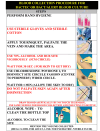Effectiveness of Multimodal Intervention to Improve Blood Culture Collection in a Tertiary Care Hospital
- PMID: 38468984
- PMCID: PMC10925844
- DOI: 10.7759/cureus.53941
Effectiveness of Multimodal Intervention to Improve Blood Culture Collection in a Tertiary Care Hospital
Abstract
Introduction and methods Blood culturing has become one of the backbone investigations for septicemia, fever of unknown origin, etc. This study was conducted to test the effect of multimodal interventions on the practical skills of healthcare workers (HCWs), raise awareness regarding the importance of aseptic blood culture collection practices, and increase compliance with the specific steps to be followed. Hence, this current interventional study was aimed at comparing the rate of isolation of contaminants grown among the blood culture specimens, assessing the knowledge, attitude, and practice (KAP) of HCWs collecting the blood culture specimen on various aspects of sample collection, educating the nursing staff regarding blood sample collection using a structured, pre-formed checklist, and emphasizing best practices for blood culture collection. All of the study's objectives were successfully met within the time frame specified. Using a pre-formed checklist and a Google form for KAP analysis eased the calculation. Results On analysis, the blood culture contamination rate in the pre-interventional phase dropped drastically from 6.16% to 3.03% in the post-interventional phase. The educational sessions conducted are a paramount reason for the reduction in the contamination rate. The HCWs were the least compliant towards the eighth step in the checklist (regarding palpation of skin); however, that too increased from 66.93% and 64.51% to a whopping 82.25% and 83.06%, respectively, with a chi-square value of 0.03 and a p-value of 0.85 (not significant). Conclusion Implementation of interventional studies as an audit like this in tertiary care hospitals can result in a significant reduction in blood culture contamination rates and can also improve the compliance of HCWs with blood culture protocols. This, in turn, can overall improve the effectiveness of blood culture (BC) testing and reduce mortality and morbidity in tertiary care hospitals. Further research can be conducted to brainstorm more methods to increase the compliance of HCWs. Better monitoring strategies can also be set to ensure low contamination rates. Additionally, some other methods can be derived to locate the source of contamination within the hospital environment and thus eliminate it. Similar interventions can be conducted for a longer duration of time to further reduce the blood culture contamination rate below 3% (as per the recommendations).
Keywords: blood cultures; healthcare workers; kap analysis; multimodal interventions; septecemia.
Copyright © 2024, Kumthekar et al.
Conflict of interest statement
The authors have declared that no competing interests exist.
Similar articles
-
A multimodal intervention to improve hand hygiene compliance in a tertiary care center.Am J Infect Control. 2018 Jul;46(7):775-780. doi: 10.1016/j.ajic.2017.12.017. Epub 2018 May 9. Am J Infect Control. 2018. PMID: 29753498
-
Reducing contamination of midstream urine samples through standardized collection processes: a best practice implementation project.JBI Evid Synth. 2020 Jan;18(1):256-271. doi: 10.11124/JBISRIR-D-19-00149. JBI Evid Synth. 2020. PMID: 31972684
-
Effectiveness of Multimodal Intervention to Improve Blood Culture Collection in the Emergency Department.J Glob Infect Dis. 2022 Feb 28;14(1):10-16. doi: 10.4103/jgid.jgid_138_21. eCollection 2022 Jan-Mar. J Glob Infect Dis. 2022. PMID: 35418732 Free PMC article.
-
Education and training for preventing sharps injuries and splash exposures in healthcare workers.Cochrane Database Syst Rev. 2021 Apr 14;4(4):CD012060. doi: 10.1002/14651858.CD012060.pub2. Cochrane Database Syst Rev. 2021. PMID: 33871067 Free PMC article.
-
Effectiveness of Preanalytic Practices on Contamination and Diagnostic Accuracy of Urine Cultures: a Laboratory Medicine Best Practices Systematic Review and Meta-analysis.Clin Microbiol Rev. 2016 Jan;29(1):105-47. doi: 10.1128/CMR.00030-15. Clin Microbiol Rev. 2016. PMID: 26598386 Free PMC article.
Cited by
-
Effectiveness of A Nurse-Led Multimodal Intervention in Preventing Blood Culture Contamination: A Before-and-After Study.Healthcare (Basel). 2024 Aug 31;12(17):1735. doi: 10.3390/healthcare12171735. Healthcare (Basel). 2024. PMID: 39273759 Free PMC article.
References
-
- A guide to utilization of the microbiology laboratory for diagnosis of infectious diseases: 2018 update by the Infectious Diseases Society of America and the American Society for Microbiology. Miller JM, Binnicker MJ, Campbell S, et al. Clin Infect Dis. 2018;67:0. - PubMed
-
- ANTT: an essential tool for effective blood culture collection. Rowley S, Clare S. Br J Nurs. 2011;20:S9-10, S12-4. - PubMed
-
- Clinical and Laboratory Standards Institute. Procedures for Collection of Diagnostic Blood Specimens by Venipuncture; Approved Standard- Sixth Edition. Wayne, PA: CLSI document H3-A6; 2007. Procedures for Collection of Diagnostic Blood Specimens by Venipuncture; Approved Guideline. CLSI Document H3-A6.
-
- Effectiveness of a novel specimen collection system in reducing blood culture contamination rates. Bell M, Bogar C, Plante J, Rasmussen K, Winters S. J Emerg Nurs. 2018;44:570–575. - PubMed
LinkOut - more resources
Full Text Sources
Miscellaneous

